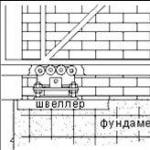The replacement of windows in the house is always accompanied by the installation of protection for the junction of the frame and the wall. Between the opening and the frame is applied polyurethane foam– traditional and proven thermal insulation. Foam regularly performs its role, but with extreme exposure to moisture or ultraviolet radiation, its quality may change for the worse.
In order to exclude the possibility of such a situation in advance and save yourself from replacement in the future, you should think about sealing the seams. To do this, you need to install additional insulation.
Full set insulation allows you to avoid freezing of the room and to minimize the penetration of moisture and noise.
The insulation of the junction of the wall with the window consists of three layers:
- Outer. Its function is waterproofing, which means protecting the premises from any weather manifestations - snow and rain.
- The carrier layer of insulation is located in the middle of the joint and is responsible for heat and sound insulation. Frost protection is provided by a porous material resembling polyurethane foam. Waterproofing prevents moisture from getting inside.
- The inner layer is also considered thermal insulation. Here the mechanism of heat conservation is different. This layer does not allow heat to escape from the inside, unlike the outer layer, which protects the premises from cold air flows from the street.

Window vapor barrier refers to the inner layer, but is not always included in the insulation system. One-sided self-adhesive vapor barrier tape or Double-sided tape for vapor barrier - this is an additional protection. The need to use tape increases if the window is installed in a room with a high moisture content: kitchen, sauna, bath.
The installation of vapor barrier tapes is no more difficult than the installation of other types of joint insulation. However, a vapor barrier can help avoid subsequent serious problems with the entire window protection system. When installing a vapor barrier in individual cases you may need a couple of additional accessories, such as vapor barrier tape. This is worth considering.
Classification of vapor barrier tapes
Vapor barrier tapes are produced in two versions:
- tapes with one adhesive side;
- double-sided vapor barrier tapes.

The first type of tape is attached to the window frame of the window. The second makes it possible to choose the place of attachment: both on the frame and in the opening.
In addition to differences in adhesive structure, tapes are divided into two types according to climatic performance:
- for predominantly warm average annual weather, "summer" vapor barrier films are suitable;
- in the presence of sub-zero temperatures"winter" tapes are used.
Adhesive surface of vapor barrier tapes
All vapor barrier films are equipped with an adhesive strip. The absence of the need to independently apply glue eliminates the possibility of poor-quality fastening of the tape, as well as moisture ingress into the heat-insulating environment.
The material for the adhesive layer of the vapor barrier tape is butyl rubber or, in cases of high humidity, metal. Tapes containing a rubber film are used for windows, balconies and doors in almost all types of premises. The basis of such a vapor barrier is a non-woven fabric.
Types of vapor barrier tapes
The most common types of tapes, depending on the material:
- One of the most popular butyl rubber tapes is PSUL (pre-compressed sealing tapes), which are responsible for external vapor barrier, finishing of external joints and tight connection of the frame and wall.
- Polyethylene tape GPL is made of foamed material. On the one hand, it is processed by lamination. The strip contains metal inserts and an adhesive part along the entire length and width. Due to its well-thought-out composition, it is almost universal and is recommended for insulating all types of door and window frames.
- Vapor barrier tape for sun windows. Suitable for insulating joints if a subsequent dry method of finishing slopes is planned. Usually used on plastic or plasterboard elements. The connecting tape protects the surfaces from the formation of condensate. The wide adhesive strip makes the process of installing the vapor barrier strip simple and fast.
- Vapor barrier tape VM. As well as other types of tapes, it is perfectly attached to window and door frames. Installation is carried out in sequence from the frame. The tape strips are overlapped to avoid possible heat leakage during operation of windows or doors.
Butyl rubber tape has a high specific gravity. PSUL tape weighs about 5 times more than a tape made with reinforced aluminum foil with the same width. The differences between the types of tapes are also in what surfaces they are usually used for. A thick rubber tape can be firmly attached to the wall, and for gluing with slopes there is no need to use heavy insulating materials. For this case, lightweight foil-reinforced strips are preferred.

GPL tapes
GPL - vapor barrier tapes that perform moisture protection as the main task. These tapes form the outer layer of insulation with an additional vapor barrier function.. Self-adhesive vapor barrier tape made of polyethylene foam.
Polyethylene foam has a porous structure, has good thermal insulation properties and almost zero hygroscopicity (does not absorb moisture). The presence of this material in the tape makes it elastic and provides high-quality sealing with any surface, including uneven.
On one side, the strip is laminated with a thin metal film, on the other side there is glue. Special moisture-resistant adhesive allows the tape to easily stick to any materials: plastic, metal, wood, brick, without requiring time-consuming preparation.
In general, polypropylene film has significant fracture and chemical resistance to both alkalis and acids. Thanks to these qualities, polypropylene vapor barrier for windows is operated without wear and oxidation.
Characteristics of the GPL
Vapor barrier tape GPL is characterized by:
- heat reflection - at least 95%;
- thermal conductivity - 0.04-0.05 W / m ° C;
- specific heat capacity - 1.95 kJ/kg °C;
- zero vapor permeability;
- sound absorption - from 32 dB.
The tape is transported in the form of a twisted roll. Gluing of the layers does not occur; a paper film is laid to prevent it.
Dimensions of GPL self-adhesive tape
Insulating strip dimensions for plastic windows characterized by width, length and thickness:
- The width varies depending on the needs of the buyer. Standard sizes- 90/120/150/200 mm;
- Typical length of a roll of a tape – 15 m;
- The thickness of the tape has two layers:
- the first insulating layer is non-crosslinked polyethylene foam, 2 mm;
- the second is the vapor barrier itself - a polypropylene film, 20 microns. This thin film relative to the entire thickness of the layer is enough to prevent condensation from falling onto the slopes of the window opening, and the entire window protection system from weather manifestations works better.
Installation of vapor barrier is carried out at a temperature of 10 ° C.

Installation of vapor barrier tape
Installation of a vapor barrier tape is built in several stages:
- Preparation and processing of a window / door opening. The surface of the walls of the opening and the frame must be free of dust. The less pollution, the more reliable the thermal insulation.
- It is necessary to mark the line for attaching the vapor barrier tape. To do this, you need to put the frame in the opening, without fixing it, and visually calculate where you want to draw the line.
- After that, the frame is removed back, and the vapor barrier strip is glued along the marked strokes.
- The paper films covering the adhesive part are removed last.
- The installation of the vapor barrier tape is completed by covering the joint with foam.
- If it is necessary to install a tape in the area under the window sill, then it is performed at the very end.

When installing a vapor barrier tape, subsequent application of plaster may be expected. In this case open part tapes must be made of a material that provides the best adhesion of the insulating strip and decorative coating between themselves.

The vapor barrier tape must be glued along the perimeter of the frame in a continuous layer, without gaps. Optimum thermal insulation is facilitated by the selection of finishing materials that border on insulation, which have an acceptable this case moisture permeability.
Vapor barrier accessories
In the installation of a vapor barrier, minor difficulties may arise - overlaps of strips and overlaps. You can consider this not dangerous for tightness, and as a result, you are likely to get problems with heat and vapor barrier. Therefore, when installing a sealed vapor barrier for PVC windows, you may need additional accessories, such as self-adhesive tape. In some cases, glue is the most convenient.
If the vapor barrier metallized tape is attached to a non-smooth surface, it may require additional reinforcing force.
Self-adhesive tape can be the same as the vapor barrier sheets themselves, one or two-sided. They are purchased if necessary to additionally glue the joints of the vapor barrier strips, correct damage to the tapes.
In the case of double overlap, adjoining the tape to wood or metal, double-sided tape is more often used. With a double overlap, i.e. when attaching a strip to pipes or doors, it is more convenient to use one-sided.
The cost of 1 running. m. vapor barrier tape averages from 25 to 45 rubles. The price tag for additional products, for example, double-sided tape, is quite high (up to 1400 rubles). Therefore, in the matter of their acquisition, everyone is guided by the installation process, the desired degree of confidence in the operation of the system and the possibility of spending money.
Video: using a vapor barrier film for plastic windows
In general, vapor barrier is not currently considered mandatory. Its installation is often determined by the choice between reinsurance against possible unpleasant situations or savings. Some manufacturers and buyers choose a budget option, which does not include vapor barrier on windows. However, a wide range of products for vapor barrier allows you to carry out the most suitable choice, while not losing on the safety of operation of the entire window system.
September 17, 2016Specialization: professional in the field of construction and repair (full cycle of finishing works, both internal and external, from sewerage to electrical and finishing work), installation of window structures. Hobbies: see column "SPECIALIZATION AND SKILLS"
Waterproofing tape for PVC windows, as well as other materials for installation, are used relatively rarely: their use increases the cost of work, since a set of high-quality mounting tapes to install one structure costs approximately 15 - 25% of the cost of the entire window.
And yet, if you plan to glaze the house "for yourself", use modern materials not only possible, but necessary. That is why I decided to write a short review on mounting tapes, their purpose and proper use.
Purpose of mounting tapes
If approached from a formal point of view, then use special vapor-permeable and vapor barrier materials for installation PVC designs necessary in the first place according to the requirements of industry standards. The use of tapes is regulated by the following documents:
- GOST R 53338-2009 "Vapour-permeable self-expanding self-adhesive construction tapes";
- GOST 30971-2012 “Mounting seams of adjoining window blocks to wall openings. General technical conditions”;
- GOST R 52749-2007 "Mounting window seams with vapor-permeable self-expanding tapes".

That is, the installation of windows in accordance with GOST without the use of tapes is impossible in principle. But there is also rational explanations the need for such materials. Some of them are set out in the already mentioned GOSTs, and some can be formulated based on many years of experience in the installation, repair and operation of translucent structures:
- To seal the joint between the window and the window opening, a self-expanding mounting foam based on liquid polyurethane is used. Despite the presence of a number of objective advantages, the foam also has disadvantages - first of all, it is vulnerability to ultraviolet radiation.
- To protect the foam from UV radiation, a self-adhesive tape is used that covers the assembly seam from the outside.

- The next aspect that justifies the need to use special tapes for mounting is ventilation, or rather, the removal of liquid. When operating a window without additional protection, which is formed in the room, is partially collected inside the installation seam, reducing the efficiency of heat saving. To avoid this, a vapor barrier material can be used to seal it from the inside of the room.
- However, it is important not only to protect the foam from moisture ingress, but also to ensure the unhindered exit of water vapor outside the assembly seam. To do this, only a vapor-permeable tape is used for exterior decoration, which guarantees normal diffusion of moist air. .

The question of whether it is necessary to glue a vapor barrier tape or use a vapor-permeable material is largely debatable. On the one hand, the effectiveness of these materials is indeed quite high, so using them in the installation will clearly affect the functionality of the window in the best possible way.
On the other hand, the price of mounting tapes is also rather big, therefore, to save money, you can choose other methods: from the inside, for example, install a slope made of plastic (in principle, it provides good hydro and vapor barrier), and from the outside - finish the mounting seam with vapor-permeable plaster, followed by painting .
And yet I repeat: the use of special tapes when installing a window structure in an opening is fully justified both in terms of standards and in terms of optimizing the indoor climate.
Varieties of materials
Type 1. Hydro vapor barrier tape
For PVC mounting Windows use a variety of tapes. Each type of such material has its own characteristics and advantages, therefore, in order to achieve the maximum effect, materials should be combined, combining their functional advantages in the best possible way.

I’ll start my review of the materials used when installing windows, with the most popular - with a vapor barrier tape:
- Self-adhesive hydro-vapor barrier mounting tape (HPL) is a tape material that covers the mounting gap from the side of the room.
- The basis of the tape is polyethylene or foam polyethylene film. On one side, the plank is laminated with a thin layer aluminum foil, and on the other hand, one or two strips of adhesive are applied for installation.
- The adhesive mixture used for application provides good adhesion to most materials - wood, concrete, brick, etc. Problems can arise when trying to paste over an opening made of gas or foam concrete, therefore, before buying mounting material I recommend consulting with the seller or carefully studying what the manufacturer's instructions say about this .
- The structure of the tape provides almost complete tightness of the finished assembly seam: neither the place of gluing nor the polyethylene strip itself allows air and water vapor to pass through.

- The polymer structure provides the product with additional advantages: finishing material is not afraid of not only moisture, but also the effects of acids, alkalis, and other chemical active substances and also does not degrade under the influence of ultraviolet radiation.
Type 2. Insulated waterproofing tape
The insulated tape is, in fact, a modification of the usual waterproofing material. Its key features include:
- increased thickness of the base, which is made exclusively from polyethylene foam;
- a denser foil layer based on a durable polypropylene film.

Thanks to these design features:
- The product is no worse than preventing the diffusion of liquid and water vapor and the penetration of moisture into middle part assembly seam. This ensures the most effective hydro and vapor barrier.
- The increased thickness of the base and its porous structure help to reduce heat loss. Foamed polyethylene acts as a window insulation.
- Finally, the foil coating also plays an important role. A thin layer of metal on an elastic base reflects infrared radiation, acting as a "thermal mirror". However, most of the heat generated heating appliances, returns to the room.

The disadvantages of such products, I would include their rather large dimensions: finishing the mounting gap with insulated tapes requires subsequent masking of the junction using slopes, which is not always included in our plans.
Type 3. Pre-Compressed Tape (PSUL)
Another versatile material- PSUL (pre-compressed sealing tape). This material is used to ensure self-ventilation of the assembly seam:

- The tape is a strip of porous polyurethane foam impregnated special composition. On the one hand, the strip is equipped with an adhesive layer protected by a special protective coating.
- The product is supplied in a rolled form (rolls or bobbins). It is necessary to unwind the material immediately before installation, since over time the product loses its properties.
- During installation protective covering removed and PSUL glued to the window structure. After that, the impregnation reacts with air, due to which the linear dimensions of the product increase. The tape expands and completely covers the mounting gap.

Full and high-quality overlap is possible only if the nominal size of the product specified by the manufacturer corresponds to the dimensions of the gap. So, for example, if I need to close a 35 mm gap with my own hands, then for work I take a PSUL with a width of about 40 mm.
- After expansion, the material becomes completely vapor-permeable. Due to this, an unhindered exit of water from the assembly seam is ensured.
Type 4. Internal tapes
In addition to the varieties mentioned above, interior decoration slopes are used and other products. Their main features are conveniently analyzed according to the table, which I will give below:

| Marking | Description |
| Sun | A product that you use for the installation of window structures, if you plan to finish the slopes in a dry way (drywall, plastic, lining, etc.). Provides effective vapor barrier, prevents moisture from entering the thickness of the assembly seam. The tape is mounted using a self-adhesive layer with a protective coating. |
| BC+ | It is used for the same purposes as the BC tape, but at the same time it has a greater thickness. An additional advantage is the presence of a foil layer, which provides more effective vapor and heat insulation. |
| VM | Hydro and vapor barrier material, which is used if it is planned to plaster the slopes on the inside of the window opening. We protect the mounting foam from moisture ingress, while ensuring maximum adhesion to the plaster mass. |
| VM+ | More effective variety the previous product is used for the same purposes. Key Feature is increased resistance to moisture. |

Other types of mounting tapes
In addition to the products described above, other types of tapes are used for the installation of translucent structures:
- Diffusion tape for exterior finish. It is used in combination with PSUL or with polyurethane foam. Provides protection of the assembly seam from moisture and ultraviolet radiation while maintaining vapor permeability. Finishing the junction with diffuse material allows you to maintain the natural level of ventilation: air will freely escape from the middle part of the mounting gap.

- Butyl rubber mounting tape under the window sill. As the name suggests, it is used to seal the junction under the window sill and protect the insulation from blowing, moisture and heat loss. Like other materials from this category, installation is carried out using a self-adhesive layer.
- Non-woven material for installation under the tide. Possesses high rates vapor permeability, glued to the foundation of the opening under the drainage strip. In addition to providing ventilation, it significantly reduces the noise of galvanized metal ebbs, acting as a shock absorber and extinguishing some of the loud sounds.
- Adhesive tape is a versatile material that is used for mounting lightweight structures. For example, reflective film on self-adhesive is popular, and mosquito net with a fastening tape is also very convenient to use.

How to use correctly?
The technology of using installation years when installing PVC profile windows is quite simple. I am using the following algorithm:

- First, I prepare the opening: I remove the old structure, level the walls, remove dust and dry all surfaces. It is desirable that the edges of the opening be more or less even, therefore, before installing the window, it may be necessary to refine them using a rapidly hardening mortar.
- Then I perform cutting of hydro-vapor barrier tapes, PSUL and diffuse material. I cut the products along the length of each side of the window with an overlap of at least 10 cm (these sections are used to form the corner joint).

- I stick the tapes on the window frame, removing the protective film from one of the adhesive strips. On the front surface of the structure, I glue PSUL in a compressed state from the outside.
It is desirable that the PSUL is completely hidden behind the wall railing, therefore, before gluing, I usually try on the window to the opening, making marks at the installation site.
- I install the structure in the opening and fix it in the chosen way - either with the help of anchors or with the help of mounting plates.

- All gaps are filled with mounting foam made of self-expanding polyurethane.
- I shoot from the inside and outer tape protective strips and glue their edges to the opening, completely covering the foam.
- If the installation is carried out in winter time, I use specialized materials with adhesive that retains adhesion at low temperatures.

- Before installation additional elements I separately glue to the support profile or the lower part of the frame a material that protects the space under the window sill and under the drainage strip.
- Under the ebb itself, I glue a PSUL strip on a horizontal surface: it acts as a shock absorber, and therefore metal visor will not rattle with gusts of wind and falling raindrops on it.
Cost of materials
As I noted at the very beginning, high price mounting tapes partially limits their distribution. But at the same time, if you know exactly what you need, there is a chance to meet the budget allotted for glazing.


Conclusion
Both vapor permeable and vapor barrier tape for plastic windows may not be included in the required set of parts for successful installation. But their use allows you to fully comply with the requirements of GOST. And also to ensure the formation of a favorable microclimate in the room - primarily due to the normalization of the assembly seam.
The video in this article will help you master the technology of using such details, and when choosing a product, you can consult with me and other experts by asking questions in the comments.
September 17, 2016If you want to express gratitude, add a clarification or objection, ask the author something - add a comment or say thanks!
Vapor barrier tapes for windows, as well as good finishing of slopes and installation seams, will provide decent window performance. In order for the window in your house to function well and for a long time, you should not miss such a moment as installing a vapor barrier tape. The hermetic tapes used to isolate the installation seam from the vapors and moisture of the adjoining premises prevent condensate from escaping onto the slopes. If you have a kitchen, a room with a pool or a sauna, then installing a vapor barrier tape on the windows is a must for you.
Varieties
Tapes can be either with one or two adhesive strips. Two adhesive strips are designed to fasten the tape with one side to the window and the other to the wall.
Installation of vapor barrier tape
Same way vapor barrier tapes are classified according to weather periods:
- for the summer period with air temperature from + 5°С to + 35°С;
- for winter period with temperatures below 0°C.
Tape width also varies depending on the needs, which allows for reliable vapor barrier of the joints various sizes. When choosing vapor barrier tapes, keep in mind that its width should be about 45 mm more than the width of the mounting seam.
Ribbons for outdoor work consist of foamed materials (for this work, good sealing materials with plaster mortar, which will provide the required vapor barrier of the outer layer).
The vapor barrier tape can be butyl rubber, for tightness of interpanel joints or for installation of door or window blocks. This tape contains a non-woven fabric. During installation, it is primed, plastered and painted. This type also self-adhesive.
For protection against high humidity mounting seam for dry finishing of slopes on the market there are metallized vapor barrier tapes.

Installed vapor barrier tape
General information on installing vapor barrier tape
- Initially, you need to prepare your opening: clean the inner and outer surfaces of the opening and frame from dirt, dust and other debris. The frame is inserted into the opening and is not temporarily fixed.
- After gently mark the line on the frame for attaching the vapor barrier tape.
- After carrying out the calculations and marking with the window, we remove the frame and glue our internal vapor barrier tapes. We do not remove the paper strip that protects the inner adhesive layer, which later attaches to the walls.
As a rule, the installation of a vapor barrier tape on the structure is carried out before the joint is foamed. Therefore, before finishing, moistening and filling with foam, you can remove the protective paper stripes with vapor barrier tapes. This will allow you not to lose the adhesive properties of the tape. If you are driving concealed installation, then from above and on the sides the tape should be attached to the ends of the structure, and from below to the installation profile.
- External heat-insulating tapes can be glued no earlier than the complete polymerization of the mounting foam.
- Installation of vapor barrier tape under the window sill can be done last. When installing a vapor barrier tape under the plaster layer, the tape must have an outer coating, which will provide the necessary adhesion to this plaster layer.
In that case if the window quarter with gaps between the frame and the wall, a different technique is used: an uneven joint can be closed with a window flashing, and a vapor barrier tape can already be glued onto it. Installing a vapor barrier tape on windows is installed in a continuous layer along the entire contour of the opening.
Do not forget that the use of finishing building materials in combination with a vapor barrier tape is allowed only if the moisture-permeable characteristics are observed.
To protect mounting seams in window openings from moisture, use a vapor barrier tape. It is made from butyl rubber or aluminum. This material is glued to the wet mounting foam at the seams, extending the life of the windows.
Is it worth it to spend money on protecting window seams?
When installing a window in an opening, remember that its service life is related to how competent the installation will be. Even the most quality constructions will not be used for a long time if the installation is incorrect. Due to improper work, moisture will gradually penetrate the walls, leading to the destruction of building materials and the spread of mold.
When installing the frame, consider a few important points:
- On the inside of the room, we make a denser layer of mounting solution (for example, foam).
- For quality termination we use three-layer protection for all gaps - the outer material saves from the effects of precipitation, the middle layer is responsible for thermal insulation, and the coating of the inner surface is for vapor barrier.
Vapor barrier provides reliable protection a heat-insulating layer from condensate, which is present not only in the bathroom, but also in ordinary room. In the process of finishing window slopes stick a special tape. The principle of vapor barrier is based on blocking the contact of moisture with the mounting foam, which forms the middle protective layer. For these purposes, materials with low elasticity and throughput for water and air . When installing windows on a vapor barrier, you can not save. Such neglect will lead to rapid wear of frames, plaster and finishing materials.
To protect the seam, special vapor barrier tapes are usually used. They come in the form of a coiled and compressed sponge-like material. Absorbing moisture, the material swells, sealing all existing gaps. The vapor barrier tape for plastic windows has a number of advantages:
- 1. insulates moisture;
- 2. it is spent economically, practically without waste;
- 3. does not emit toxic substances;
- 4. easy to stick;
- 5. has a long service life.
Classification - what characteristics to look for
Tapes for moisture insulation are produced with one and two strips of glue. The second option allows you to process the joint of the window with the wall more efficiently. The material is classified by periods of use:
- summer (air temperature - 5-40 ° C);
- winter (temperature below 5 °C).
Depending on the nature of the surface to be treated, the tapes are produced in various sizes, so that any seams can be isolated. When choosing a material, keep in mind that it should exceed the gap by 4.5 cm in width. To work with outside buildings are suitable for foam tapes, which will provide reliable sealing.

Moisture Insulation Tape
Adhesive finishing material made of butyl rubber, designed for processing window, balcony, door frames and joints between panels. Inside it is laid non-woven layer. After gluing, such a strip is primed, plastered, wallpapered or painted. There is a full-butyl vapor barrier tape made according to the Robiband system. It provides more quality processing assembly seam.
Metallized vapor barrier material is used for gluing seams with joints in rooms with high air humidity - bathrooms, baths, saunas. A layer of glue over the entire surface in this form greatly simplifies the work process. Manufacturers produce metallized tape of different widths. When selecting material, add 45 mm to the width of the seam.
The tape, which has a protective strip of polypropylene, withstands well mechanical impact. In addition, it does not react with acids, organic solvents and alkali.
We understand the variety of types of tapes - VS or GPL?
First on the list is PSUL (pre-compressed self-expanding sealing tape). It provides a high-quality fit of the window frame or door frame to the wall. This tape is used for vapor barrier of external joints and seams.
The next material is vapor barrier VS. It is used for sealing seams when dry finishing is performed. For example, under sandwich panels, drywall, plastic surfaces, etc. The tape has a layer of glue across the entire width - this property greatly simplifies the installation process. There is an improved version - BC +. It is supplemented with an anti-adhesion film. This additional coating provides a strong adhesion of insulation to building materials.

Robiband VM tape for vapor barrier - next quality option seam material. It is used for internal works, and a wet plaster solution is applied on top. Vapor barrier VM + is a sophisticated option with better performance.
The last type is GPL (hydro vapor barrier material). It is made from polyethylene foam. High Quality. The tape has one laminated side, as well as an additional metallized layer. Its second surface is completely covered with glue. This tape is universal, that is, it can be used for all types of work. Its variety is GPL-S tape, which has similar characteristics.
How to stick insulation - we work without errors
The vapor barrier material not only provides protection against moisture, but also has an alternative property when correct gluing- noise reduction. Applying a vapor barrier tape to the seams is done in one piece, there should not be any gaps. Before starting work, measure the length of the surfaces to be treated.

The gluing process consists of several steps:
- 1. Clean the window opening from dirt, dust and debris.
- 2. Before installation, remove the PVC window and wipe it with a dry cloth.
- 3. Put the structure in place and mark on the frame and wall where the tape will be attached.
- 4. The tape is attached to window frame before applying foam at the seam.
- 5. Remove the structure and stick a vapor barrier on its surface around the perimeter.
- 6. Before installing the window in place, remove the remaining protective film from the adhesive surface.
- 7. When pasting the material, do not allow the formation of wrinkles. This defect will allow drops of liquid to pass under the vapor barrier, degrading performance.
To window construction served for a long time, its installation must be carried out with strict observance of the existing technology. Outer material for steam, heat and water insulation, it is necessary to glue after the mounting foam is completely polymerized. We process the seam under the window sill last.
If the tape is glued under a layer of plaster, then it must have a special layer that will provide strong adhesion to building material. Irregular joint between wall and window frame closed with a flashing, and a vapor barrier is glued on it. The use of building materials for wall decoration is permissible only if the requirements for water permeability are fully met.
If a metallized tape is used for vapor barrier, then additional reinforcement may be required when applied to a rough surface. To enhance the adhesive effect, self-adhesive tape with one or two adhesive strips is used. They are additionally treated with vapor barrier joints, eliminating and smoothing defects (places of peeling and wrinkling) formed during work.
Able to increase quality characteristics design, which extends its life. On sale you can find such tapes that have an adhesive strip on one or both sides. It is designed to fix the tape to the window and wall. Among other things, such materials are classified according to the temperature characteristics during operation.
The first variety is suitable for the summer period and can be used in the temperature range from +5 to +35 ° C, while products intended for winter can withstand temperatures below zero degrees. The width of such a strip can vary depending on the tasks, which allows it to provide vapor barrier of the seams. different sizes. When choosing a vapor barrier tape, you should take into account that its width should be 45 mm more than the installation seam.
general description
The described tapes for outdoor installation can consist of foam materials, they are required for and can be used in conjunction with a plaster mortar, which increases the vapor barrier characteristics. There is a vapor barrier tape for windows on sale, the characteristics, the photo of which is presented in the article. Such material may be based on butyl rubber, which is intended for sealing joints and installation on windows and the Product consists of nonwoven fabric, during the installation it is primed, at the next stage it is covered with plaster, and at the final stage it is painted. This type has a self-adhesive layer. If you need a vapor barrier tape that will be used in high humidity, then you should install the material under the dry finish of the slopes, using a metallized variety.
Characteristics of foil vapor barrier tape
Foil hydro-steam and heat-insulating tape is glued to cleaned, dry, as well as previously degreased surfaces. The material itself is supplied in boxes, the dimensions of which are 420x420x600 mm. It must not be operated at temperatures below +10°C. The tapes are based on foamed polyethylene, which is laminated and metallized with a polypropylene film on one side, while on the other side there is a waterproof adhesive layer that reliably secures the material to concrete, brick, metal, plastic and wooden structures.

It is based on a material that consists of a closed cellular structure, it has low hygroscopicity and almost does not absorb moisture. Elasticity is provided thanks to polyethylene foam, which guarantees the sealing of seams with varying degrees bumps. high mechanical strength was achieved due to the presence of a polypropylene film, which is resistant to alkalis, organic solvents and acids. The reflective layer is protected from mechanical damage and oxidation. The adhesive layer consists of a water-resistant adhesive, which is created on the basis of synthetic rubber. It has improved adhesion qualities with different materials, which allows the use of the tape without pre-training surfaces.
For reference
You can not be afraid that the vapor barrier tape will stick together in a roll, as there is a protective siliconized layer on its surface. Such steam-hydrothermal insulation is used for seams, knots and joints of various building structures, including when installing window blocks, wood, metal, plastic and concrete products.

Material dimensions
The thickness of the film is 20 µm, while the length is 15 m, and the width can vary from 90 to 200 mm. 120 and 150 mm act as intermediate values.
Specifications
Vapor barrier tape for windows has a high coefficient of thermal reflection, which reaches 95%. The coefficient of thermal conductivity is very small, and at 20 ° C it is in the range of 0.038-0.051 W / m ° C. The heat absorption coefficient during the day reaches 0.48 W / (m 2 ° C). The thermal resistance is 0.031 °C/W, which is true for one millimeter of thickness. Professionals are sometimes also interested in such a characteristic as specific heat. In the case of the described one, this parameter is 1.95 kJ / kg ° С.

Under load within 2-5 kPa, the dynamic modulus of elasticity can vary from 0.26 to 0.6 MPa. Vapor barrier tape for windows has another significant advantage, which is expressed in the ability to absorb extraneous noise. Thus, the sound absorption is 32 dB. The material belongs to the combustibility group G2, smoke-generating ability - D3. The density of the material can be equal to 50 and 80 kg/m 3 .
Features of installing the sealing tape
Vapor barrier tape for windows specifications which were presented above, should be established according to the algorithm developed for this material. For internal sealing of the seam, a duplicated vapor barrier tape based on aluminum foil is used. For reliable and easy fixing, it has adhesive strips, which are located on both sides. The tape must be installed around the entire perimeter of the window, and then closed with slopes that are installed in a dry way.

To install the internal vapor barrier tape at the first stage, it should be cut into separate pieces, the length of which will be equal to the width and length of the window. To this value, you must add 10 cm, which will go to corner connections. Along the length, the tape is overlapped, the width of which should be approximately 1/2 of the width of the material.
Work methodology
The vapor barrier tape for PVC windows, the use of which is described in detail in the article, is released from the protective paper on the side of the duplicated strip at the next stage. The material can now be glued to the frame profile. This must be done in a taut state, and the inner edge of the adhesive layer must coincide with the inner edge of the frame. protective layer, which is on the butyl rubber coating, should not be removed at this stage.

In order for the adhesion of the adhesive strips not to be reduced, it is necessary to keep the structure open for a shorter amount of time, and before gluing the window surface must be wiped with a soft rag or paper towel.
Conclusion
Vapor barrier tape for windows, the density of which was mentioned above, must be installed in one piece, breaks at flat surfaces should not be. At the final stage, you need to install the tape on the windowsill, and then assemble the window with the sashes.


















